
Baden-Powell Council BSA
at the
2016 Blair Atholl Patrol Jamborette
Day 3 - July 14th - York, England
York is one of my favorite spots in all of the UK - a compact city still within its medieval walls. It was only a short walk from the Scout Hall to Bootham Bar, and then inside the city walls and through the narrow, winding medieval streets to breakfast at what has to be the most subdued McDonalds in the world.
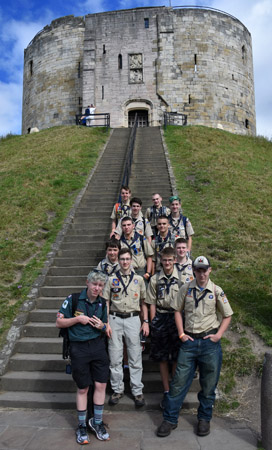 Our group on the steps of Clifford's Tower, all that is left of the medieval York Castle. |
 York is known for its narrow "snickleways". |
 A Tudor half-timbered house in York |
 High Petergate, just inside the walls at Bootham Bar |
 River Ouse |
 The Shambles - once the butchers' district, with raw meat hanging everywhere, it is now a tourist street full of gift shops. The Scouts took their time wandering in the stores and through the market behind the houses on the left. |
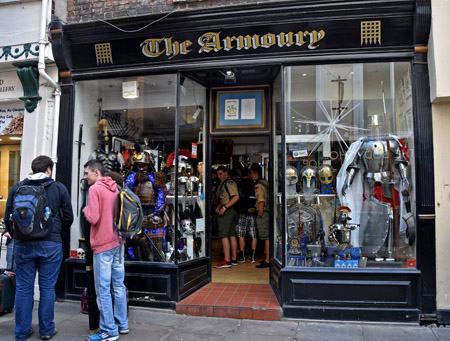 What Scout could resist a store full of swords and armor? |
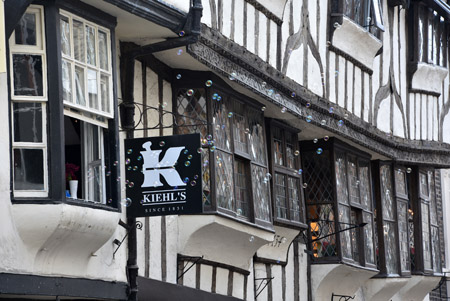 Bubbles on the Shambles |
 After lunch, we climbed up onto the city walls and followed the wall walk back around to Bootham Bar. |
 |
 York Minster from the wall walk, overlooking Gray's Court Inn |
 York Minster from Duncombe Place |
 "The Cathedral and Metropolitical Church of Saint Peter in York" - or "York Minster" for short. Although it's not very short - York Minster is the largest Gothic Cathedral north of the Alps. |
 One of the side chapels of the Minster - note the window where the stone tracery doesn't seem to really fit in the surround, and the pointed arch is asymmetrical. We asked our tour guide about that, and he spent the rest of the tour pointing out the many spots where the stonemasons of the Minster didn't quite get things aligned right. When a cathedral takes generations to build, styles evolve and there aren't real plans, sometimes things just don't work out... |
 Our tour guide with the Scouts |
 Everywhere you look, the Gothic Cathedral is stunning... |
 |
 This is why York Minster is a Cathedral - because it has a "cathedra". That's a throne for a Bishop, and a church with a Bishop's cathedra is a Cathedral.. |
 Although it was built over a period stretching from 1220 to 1472, work on York Minster has never really stopped, and it remains a living and evolving building. The year after my first visit to York Minster in 1983, there was a devastating fire which burned down the roof in the South Transept and did millions of pounds in damage. Repairs took four years to complete. |
 When the roof was replaced, the BBC's Blue Peter children's program ran a competition to design new roof bosses, appropriate to the late 20th Century. These are two - a Scuba diver and whale, and an astronaut and stars in a crescent moon. |
 The Chapter House, where the governors of the Minster met (and still meet), was built in the 1260's-1290's. Sculptured heads embellish the wall above each of the seats, no two alike. |
 By tradition, the stonemasons could sculpt pretty much anything they wanted for the decorations. Were these portraits of real people in 13th Century York? Is this man expressing horror or disdain? One wonders what the story might have been... |
 Probably the only medieval sculpture of someone picking his nose you're likely to see... This had to be someone the stonemason knew - but who, and why portray him this way? |
 Sculptures continue to be made for the cathedral. These modern headless statues communicate in a way which should be recognizable to anyone who was a Scout before the 1970's. The complete row of statues, extending across the western end of the nave, sends the message "Christ is here" in semaphore. |
 Looking upward into the tower, built between 1407 and 1472 |
 York Minster is known for its stained glass, over two million pieces of it. |
 Each of the windows is carefully removed and cleaned on a regular schedule - about every 150 years. Talk about a "to do" list... |
 I like the editorial comments by the restorers in the '50's. |
 |
 The great Rose Window in the South Transept |
 |
|
 We were told about this view of the Minster by one of the storekeepers in the Shambles. He said it was the best view in York. It's not hard to get to - just ride the escalators to the cafe on the top floor of Marks & Spencer. |
 A gargoyle (rain spout) on the outside of the Minster |
 After our tour of York Minster we walked over to the National Railway Museum. Adjoining the York railway station on the site of the former York North locomotive depot, it's the largest such museum in the UK. |
 The museum houses over 100 locomotives of all sizes and types. |
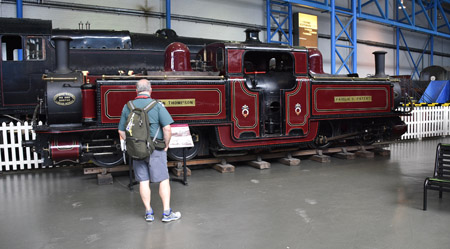 A "pushme-pullyou"? |
 |
 When we last visited the Museum in 2006, the Flying Scotsman was lying in pieces in the restoration shop. On this visit it had just returned to the musuem, having just returned to the rails after a ten-year restoration. |
 |
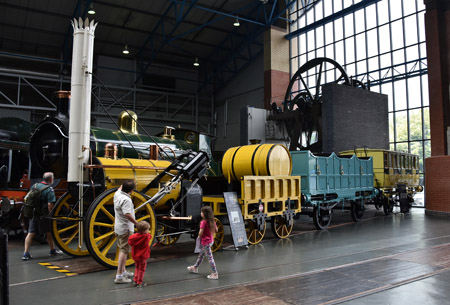 Stevenson's Rocket |
 The museum's unique warehouse, where all sorts of artifacts are stored for future use, but are still viewable by visitors. |
 After the Railway Museum, we hiked back to the Lord Mayor's Own Scout Group hall to pick up our gear. Back to the railway station, and after a quick dinner on the platform, we boarded our train to Edinburgh. As you can see on the GPS, trains in the UK move right along - at 123MPH, we were in Edinburgh in a couple of hours. Our hired minibuses were waiting for us at the Park'n'Ride tram stop, and we arrived in Stirling for our overnight stay with the 7th Beechwood Scouts at a not-too-unreasonable hour. "Thanks" to the 7th Beechwood for their hospitality - we'll be back there someday, too. |
|